BMW X3 (2018-2023) Review
Written by Andrew Brady
Quick overview
Pros
- Brilliant cabin and in-car tech
- Strong and efficient engines
- Boot is both big and clever
Cons
- Only room for five
- M Sport models are a little firm-riding
- Expensive optional extras
Overall verdict on the BMW X3
"The BMW X3 is the brand’s mid-size SUV, so it's big enough to give you a great view out over other traffic and handle family transport duties with zero fuss, yet small enough to not feel cumbersome on British roads."
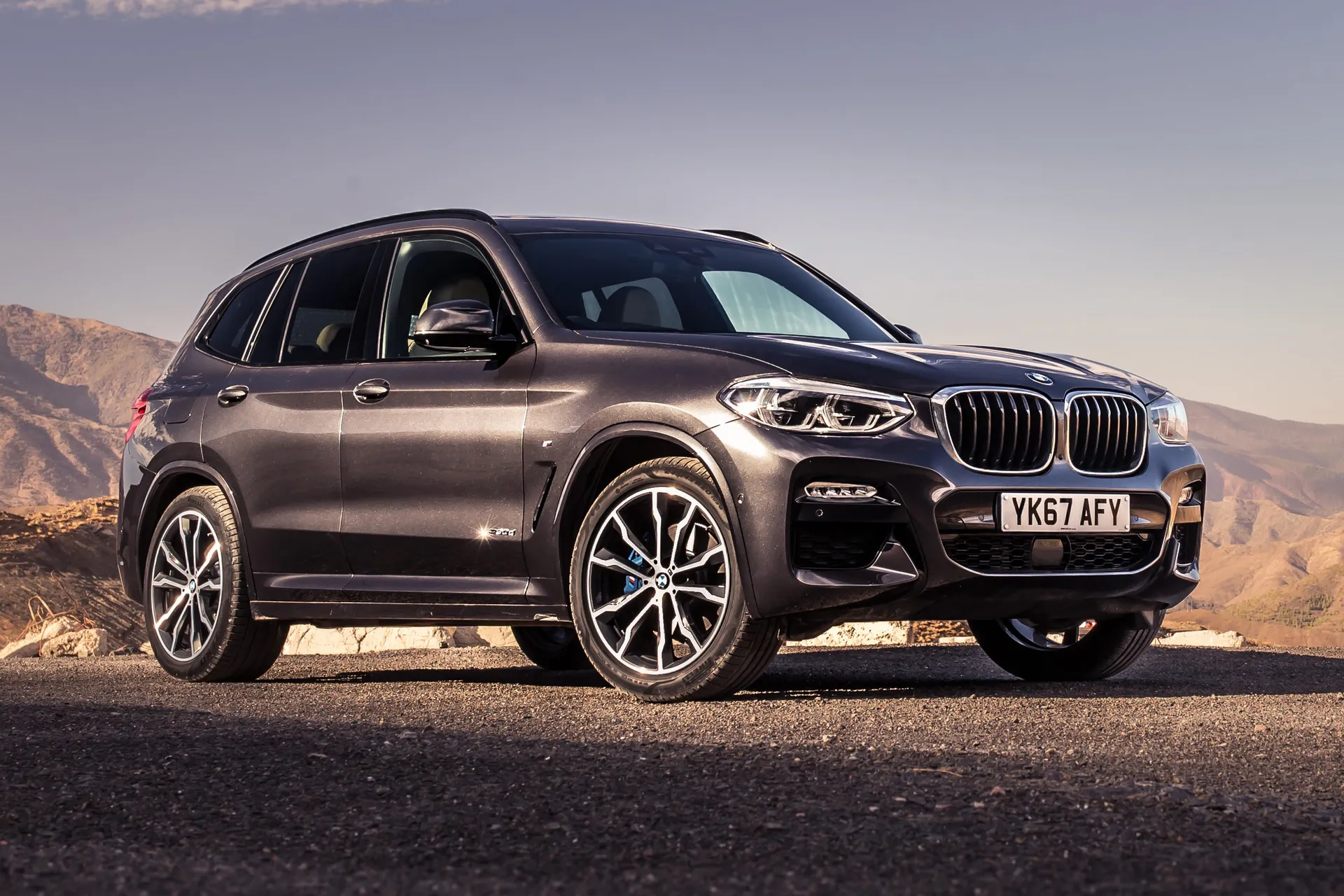
The BMW X3 is best described as a taller and more useable 3 Series. It's also more desirable these days, as SUVs are less compromised on practicality, and the rugged design and raised driving position has become hugely popular. We'll see if that's justified in this BMW X3 review.
Unlike some 'proper' 4x4s, the BMW X3 is more focused on delivering a composed - even sporty - on-road driving experience, rather than tackling extreme terrain, so it suits most buyers' daily routine.
Few SUVs strike a better balance between road-holding and comfort, especially when fitted with the optional adaptive dampers. It's a plush-riding car, and the X3 is more entertaining to drive than its peers; the Volvo XC60, Audi Q5 or Land Rover Discovery Sport. It grips tenaciously in corners and feels more planted and stable than heavier rivals as it changes direction.
The engine range also impresses, with both four- and six-cylinder petrol and diesel options that are smooth, and strike a fine balance between gutsy performance and decent fuel economy.
If you really want to save money at the pumps, there’s also a plug-in hybrid (PHEV) version with a pure electric range of up to 30 miles, and combined CO2 emissions of just over 50g/km for an ultra-low Benefit-in-Kind (company car tax) rate.
Topping the range is the BMW X3 M, a high-performance flagship variant with the same engine that also powers the M3 sports saloon, with over 500bhp and a ballistic 0-62mph time of just 4.1 seconds - it's a real rocket ship. Still, most buyers will be more than satisfied with the tractable and frugal 2.0-litre diesel in the xDrive 20d.
Inside, the BMW X3 offers everything you’d want from a premium SUV: space, comfort, and stunning quality. It has a comfortable driving position, the dashboard design is attractive and modern, and there are enough practical touches to cope with the daily grind. Material quality is first-rate, and the specification list is as fully stocked as Nigella Lawson's fridge.
All X3s come with leather upholstery, heated seats, an electric tailgate, and sat-nav. The 8.8-inch screen is superb, but the upgraded display and digital dials on M Sport models feel truly cutting-edge. It's one of the best infotainment systems, partly due to the impressive hardware but mostly because it's just so easy to use. From the 2021 facelift onwards, all cars came with a bigger 12.3-inch screen as standard, which is also brilliant.
The boot is as spacious as in its closest rivals, and it's cleverly designed to help you maximise the generous 550-litre load capacity with a minimum of fuss. However, that space decreases to just 450 litres in plug-in hybrid model, with the electric motor and large batteries taking up a lot of space underneath the boot floor.
Where the X3 really stretches ahead of its rivals, though, is value for money. It feels luxurious and well built in the cabin, justifying its premium price, but it's better equipped, cheaper to insure and more efficient than many rivals. Combine that with its keen handling, powerful engines and decent practicality, and it's a class-leading effort.
Looking for a used car for sale? We've got 100s of BMW Approved Used Cars for Sale for you to choose from, including a wide range of BMW X3s for sale. If you're looking for the newer version, you need our BMW X3 review, while you might also be interested in our previous generation BMW X3 (2010-2018) review.
Is the BMW X3 right for you?
The BMW X3 is from that modern breed of SUVs that are far more comfortable on the road than anywhere else. It has four-wheel drive to help in wintry weather and boost traction on greasy surfaces, but it's no Land Rover when it comes to climbing every mountain and fording every stream.
Still, if you want a large and practical family car that's a bit more rugged than an estate when it counts, it's a hard car to fault. Passenger and boot space are both generous, and the quality of the cabin speaks for itself.
It comes alive on a twisty road, giving you the confidence to drive it with purpose, but remains wonderfully comfortable and quiet on long motorway stints. It's perfect for buyers who want to have their cake and eat it.
Yet perhaps the most impressive aspect of this car is the fuel economy. It's one of only a tiny handful of big, four-wheel drive SUVs that can return well over 45mpg, even with a powerful six-cylinder diesel engine underneath the bonnet. With an excellent plug-in hybrid model designed for company car drivers, low running costs are a major plus.
What other cars are similar to the BMW X3?
The BMW X3 sits at the sportier end of the mid-size luxury SUV spectrum, so its natural rivals are from brands who put the driver at the centre of the action. The Jaguar F-Pace, Alfa Romeo Stelvio and Porsche Macan all fit the bill.
Since the latter is pretty expensive, it only really competes with the six-cylinder versions of the BMW, and is nowhere near as well-equipped for the price, while the Jaguar and Alfa fail to match the X3 for cabin quality (although the F-Pace is now closer than it was before it was facelifted).
Audi's Q5 certainly measures up when it comes to cruising refinement and ride comfort, but its dated MMI infotainment hardware is not as slick to use as the iDrive infotainment in the BMW, and it has fewer engines.
If you don't necessarily need four-wheel drive, then the Range Rover Evoque is a stylish, more affordable alternative that can be had in front-wheel drive format, or as a plug-in hybrid. In most respects, though, the X3 is a much better car.
We'd also recommend looking at BMW's own 3 Series Touring unless you're convinced you need a high-riding SUV. It's even better to drive, more efficient, features many of the same engines, and is cheaper, too.
Comfort and design: BMW X3 interior
"Setting off on long journeys will hold no sense of trepidation for BMW X3 owners. The standard seats are really comfortable, offering good back and thigh support, toasty heaters, and a commandingly high driving position."
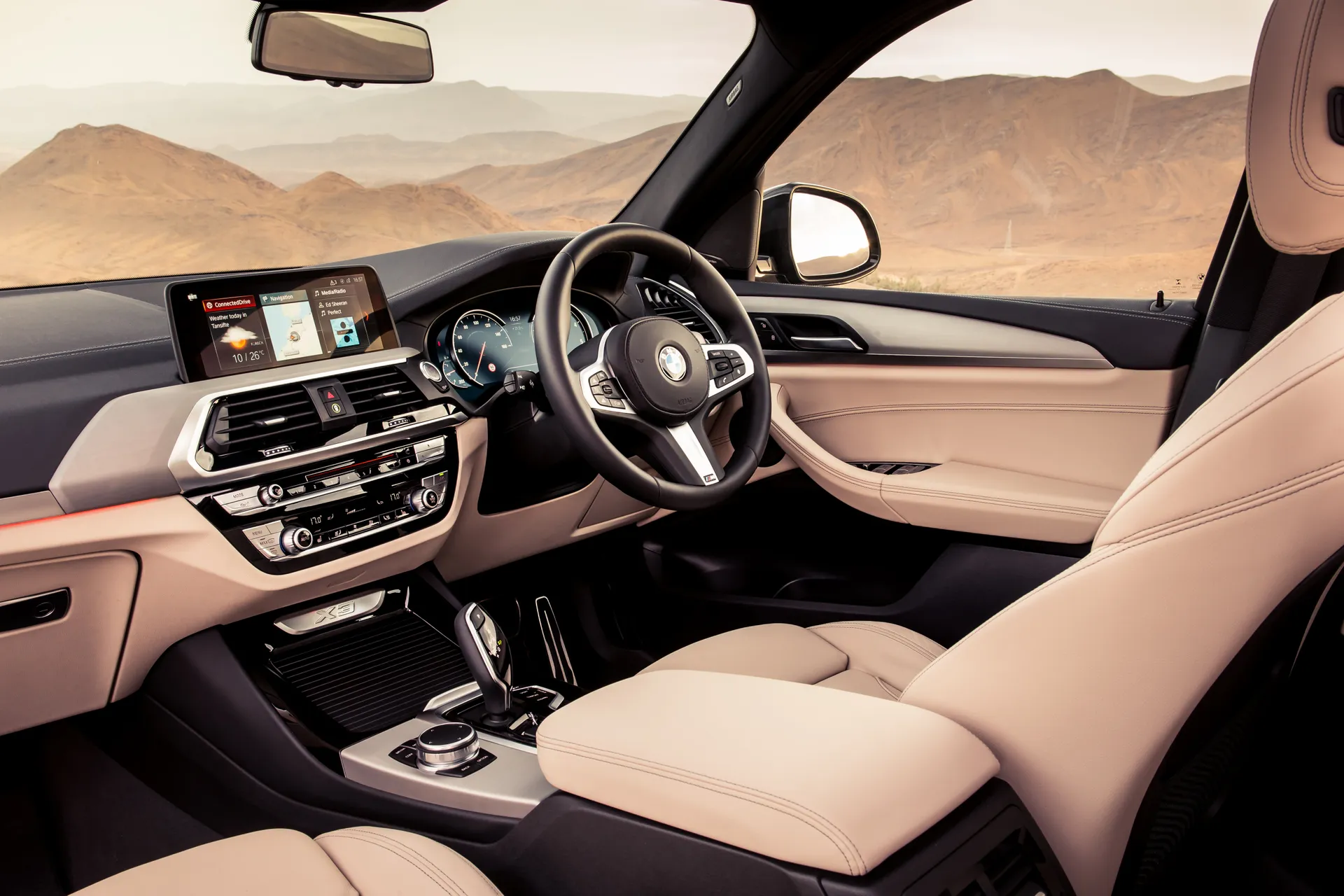
You have a great view out in the BMW X3, and it's easy to judge where the bumpers end, so it doesn't feel too intimidating to weave through city traffic, although we're glad there are sensors and a camera to assist you when parking.
From the xLine model upwards you get figure-hugging sports seats that hold you tighter around the waist, while the M40i and M40d models have electric adjustment with memory buttons that will store your favourite settings.
We do think it mean of BMW not to provide lumbar support on any model, which can make a huge difference to the state of your lower back after hours spent behind the wheel, but it is offered as an inexpensive option. Meanwhile, the pedals are nicely spaced, and there is a wide footrest to prop your left leg up while cruising.
The layout is more conventional than in rivals such as the Volvo XC60 and Land Rover Discovery Sport, with a greater number of physical controls for the audio, climate and infotainment settings. Still, the switches are thoughtfully grouped together and clearly labelled, so once you've acclimatised to the cabin, it's very intuitive.
The digi-analogue dials on lower-spec cars are slightly easier to read than the fully digital items on M Sport trim (the fully digital ones later became standard across the range), since the speedo and rev counter are pushed to the corners of the 12.3-inch display, but it's a minor gripe.
Quality and design
For years Audi felt like the unshakeable class leader when it came to building interiors, but the BMW X3 can now stand shoulder-to-shoulder with the current Q5 when it comes to the quality, execution and finish of its cabin.
Every major surface is covered in yielding, soft-touch plastic that looks and feels great, the seats are trimmed in leather, with SE cars getting black hide, and other trims offering a wide a choice of brown, beige and white. Attractive gloss black and brushed metal trims on the centre stack keep things looking interesting, heightening the air of quality inside.
All the controls feel sturdy and robust, operating with an oily precision that's really satisfying, and there is no discernible drop in material quality between the passenger space in the front and the rear, which is unusual.
For the ultimate sheen of luxury, you can fit a metallic finish for the window switches, steering wheel controls and audio and temperature dials. It's not a particularly expensive option but looks great, so we recommend it.
Depending on the trim level, you can fit polished wood, carbon fibre, aluminium or piano black dashboard finishers, but every car feels solidly constructed. If cared for, it should look as good after five years use as it did when new.
Infotainment: touchscreen, USB, nav and stereo in the BMW X3
The iDrive system in the BMW X3 is one of the best you can get in any premium car. It's intuitive, with bright, colourful displays, detailed graphics, and you can interact with the car using touch, voice, or physical controls.
Early SE and xLine cars came with an 8.8-inch central display that's better than the systems in its rivals. It responds instantly when you press or swipe the screen, although the rotary dial by the gear stick is still the best way to control it while driving. The system comes with all the essentials you'll need. DAB radio, Bluetooth, sat-nav, connected online services and Apple CarPlay and Android Auto smartphone mirroring all feature.
These models have a set of digital/analogue dials that remind us of a nineties Breitling pilot's watch, with a built-in screen showing simple route and driving information, surrounded by a stylish speedo and rev counter.
Rather than offering an upgraded system on the options list, BMW reserved its best technology for M Sport versions, which take things up a notch with a 10.25-inch touchscreen, and 12.3-inch set of fully digital dials. The brand calls this its 'Live Cockpit' but it's not as easy to read, nor as clearly laid out as Audi's own version.
The standard stereo is pretty good, but those who wanted to really get the windows rattling could specify a punchy Harmon/Kardon system with 16 speakers, a 600W amplifier and rich, resonant sound reproduction. However, it was only available as part of the costly Technology Pack, and could only be fitted to top spec models. Still, you got a head-up display, wireless phone charging and WiFi hotspot included, too.
The X3 was facelifted in 2021, and this brought a new infotainment system that included a 12.3-inch central screen and 12.3-inch digital instrument panel throughout the range. Again, this system looks fab and is generally easy to use.
Space and practicality: BMW X3 boot space
Squeezing your luggage into the BMW X3 is made easier than in some rivals thanks to its clever design solutions. It has a 550-litre load bay (exactly the same as its key German rivals) and while it can’t expand that area by sliding the seats forward, there are loads of handy features that should make it incredibly easy to live with.
For starters, the boot opens electrically with the push of a button. Need to drop the rear bench? Pull a pair of handles in the load bay and they fold themselves gracefully into the floor, lying almost perfectly flat and level. They split three ways, giving you the flexibility to carry awkward luggage and two adults without any issues.
There's no lip on the edge of the boot, so you can slide heavier items straight inside, and if you need to pack even more in there's a massive cubby under the floor, which has gas struts to hold it open while you fill it up. Size-wise, it can carry 1,600 litres with the seats folded, slightly more than an Audi Q5.
Passengers on board are well catered for, too, since the tall roof and boxy dimensions provide ample head-, knee- and shoulder room, even for tall adults, whether they want to sit in the front or the back. Find a car fitted with the optional 'Comfort Pack', and you'll have the ability to recline the backrests, but you can't slide them to free up extra space.
A Land Rover Discovery Sport has both features as standard, and gives buyers the option of seven seats. Even in five-seat mode, it caters better to having three across the middle row, which is a tight fit in the X3. You can fit a Group 1/2/3 or iSize child seat in the back, and accessing the rear Isofix points is no chore.
The Comfort Pack we mentioned also boosts the already impressive interior storage options. It adds a spot for the driver to stash their sunglasses, a lockable glovebox, 12V socket with USB adaptor between the rear seats (perfect for keeping kid's devices charged up), and extra hooks and lashing points in the boot. You'll have no problem stowing odds and ends in the standard car, but for families, this is a worthwhile upgrade.
In terms of exterior dimensions, the BMW X3 is 4,708mm long, 1,891mm wide (excluding mirrors) and 1,676mm tall. That puts it roughly in the middle of the class in terms of size, being longer than the Land Rover Discovery Sport, shorter than the Jaguar F-Pace but ever so slightly larger than the Mercedes GLC and Audi Q5.
Handling and ride quality: What is the BMW X3 like to drive?
"BMW likes throwing around its 'Ultimate Driving Machine' tagline, whether it's trying to sell you a hatchback or a luxury limousine, but in the X3's case, this really is one of the sweetest handling SUVs on the market."
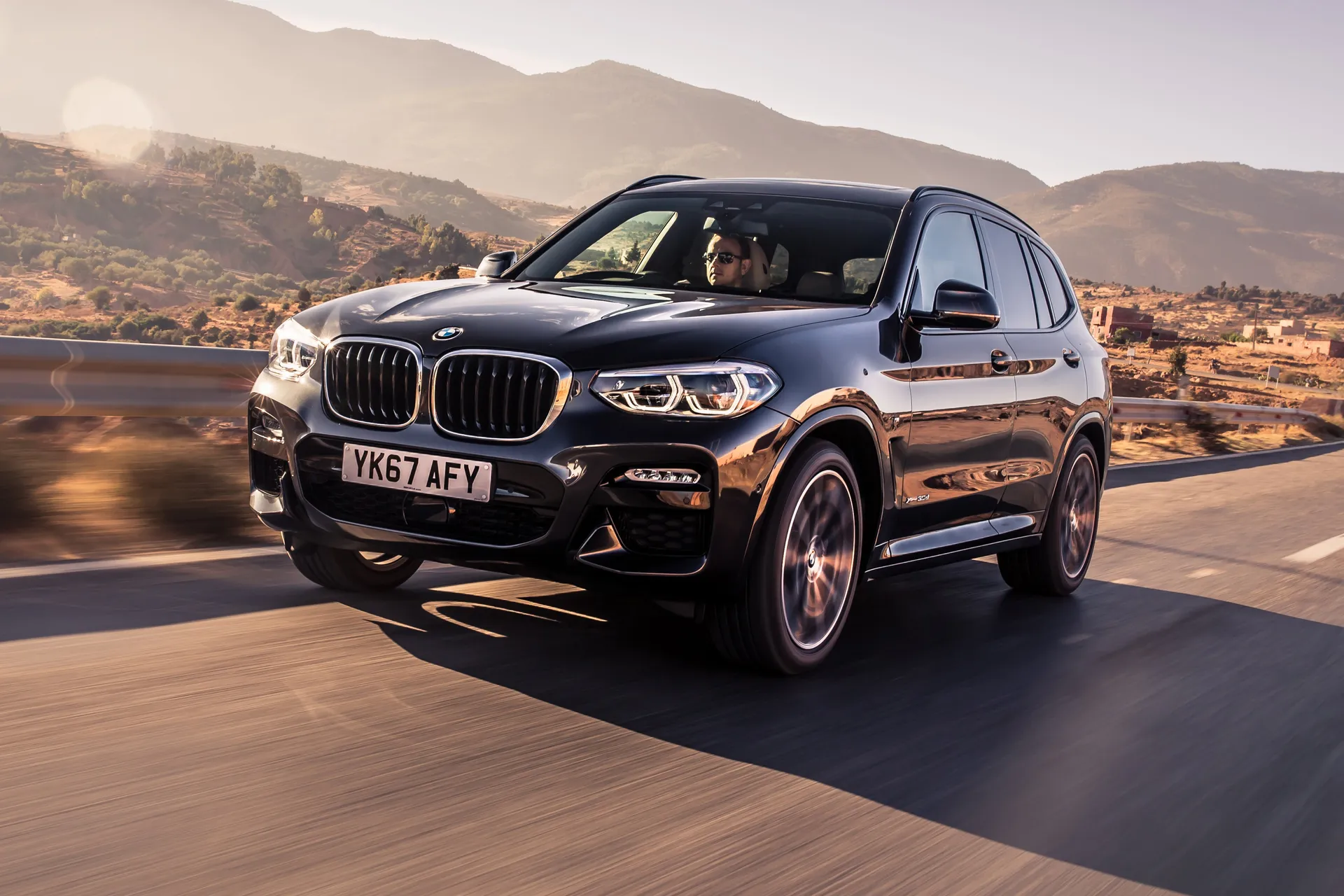
The BMW X3 strikes an excellent balance between comfort and poise, isolating you from the scruffiest surfaces without losing an ounce of composure on faster, challenging roads that would flummox its rivals.
The four-wheel drive system sends more power to the rear wheel than the fronts, giving you a sling-shot feel when exiting corners that makes it feel more balanced than its competitors, while still generating huge grip.
The accurate steering varies its weight depending on your speed, lightening up for low-speed manoeuvres so it feels wieldy in busy car parks and narrow suburban streets, and it feels less cumbersome than a Land Rover Discovery Sport as a result. On fast roads, the steering weights up for added stability on straights and more confidence in corners.
Models with large wheels will fidget on pockmarked Tarmac, transmitting small imperfections up into the cabin with greater frequency than cars rolling on fatter tyres, while M Sport trim has a lower setup that's pretty firm. Some compliance is restored if you find a car fitted with a set of adaptive dampers, part of a costly option pack. They give the X3 a better bandwidth; soft enough in Comfort mode to be stress-free, while also being taut and controlled enough in Sport mode to be fun to hustle about it.
Unlike the top-spec versions of the Audi Q5 and Mercedes GLC, air suspension couldn't be specified, so it won't match those models for the wafty 'magic carpet' feeling you get from gliding along on big inflatable cushions. Still, it rides perfectly well on the adaptive dampers and neither rival gives its driver as much feedback and control as the BMW.
Every X3 drives well, but thehigh-performance M40i, M40d and (in particular) the X3 M have been tuned by the brand's motorsport department. Each has a bespoke setup that gives this tall off-roader impressive cornering ability and handling responses. A Porsche Macan possesses even more precise steering, but in all other respects the hottest X3 matches it.
What engines and gearboxes are available in the BMW X3?
Buyers are really spoilt for choice with the BMW X3. There's an engine for every budget, from ultra-efficient hybrids to searingly quick high-performance variants. All of its motors impress, though, so it's hard to put a foot wrong.
Whichever engine you go for, it'll be paired up with BMW's excellent xDrive four-wheel drive system, sending power to each corner through a fantastic eight-speed automatic gearbox that's one of the smoothest on sale.
Kicking off the range is a 2.0-litre four-cylinder petrol, badged xDrive 20i. With 184PS, it's no slouch, but it lacks the overtaking grunt and impressive economy of the xDrive 20d diesel, which is our pick of the range.
The latter will have more than enough performance for most buyers. It can cope with towing, and haul the BMW X3 around without feeling strained, even when you're fully loaded with passengers and luggage. However, the 3.0-litre six-cylinder in the xDrive 30d absolutely flies along the road, and it's a smoother, quieter cruiser, too.
For the ultimate blend of performance and efficiency, the petrol-electric xDrive 30e is a plug-in hybrid, pairing a 2.0-litre petrol engine with a 109PS electric motor. It has very similar performance and electric range to its main rival, the Audi Q5 50 TFSI e, letting you take short trips – up to about 30 miles – without burning any fuel.
However, we'd only recommend buying it if you can regularly charge it (ideally at home or at work). For drivers covering higher annual mileages, the cheaper, more consistently economical diesels will still make more financial sense.
If you think all of the above options sound like they lack firepower, then you can indulge in either the M40i or M40d. Both are indecently quick off the line, and will give anything this side of a Porsche a run for its money.
The cherry on top of the cake is the X3 M, essentially a hot-rod saloon shoehorned into an SUV body. It has a rampant 500PS output, competing with the Alfa Romeo Stelvio Quadrifoglio, Mercedes GLC 63S, and Jaguar F-Pace SVR.
It's as expensive, wild and uneconomical as that recipe sounds, but certainly gives your family SUV an added shot of adrenaline. It sacrifices a lot of comfort, however, with a harsh ride that seems out of kilter with a family car such as this. Really, the M40i is plenty fast and exciting enough for all but the most die-hard performance fanatics.
Refinement and noise levels
Spending hours at a time travelling in the BMW X3 will be no hardship, because it's one of the most refined cars in its class.
It has thicker 'acoustic' glass fitted to the windscreen and front windows across the range (unlike in the Audi Q5, where it's trim-specific) and it does a brilliant job of isolating you from wind flutter, engine noise and road noise. Of course, it can't defy physics, so the largest diameter alloys still create some tyre roar on coarse surfaces.
The 2.0-litre diesel in the xDrive 20d is not the most refined four-cylinder. In fact, it sounds a bit gruff when starting or accelerating hard, but it won't disturb you too often once you get it up to speed.
However, the straight-six in the xDrive 30d and M40d is a horse of a different colour. It's super-smooth right across its rev range, makes about as good a noise as a diesel can make, and delivers effortless performance to make for serene progress.
If you want a more melodramatic soundtrack, the M40i snarls, crackles and pops in Sport mode, but you can tone everything down again when you're just traipsing along, or to avoid getting ASBOed by the neighbours. Unsurprisingly, the plug-in hybrid xDrive 30e is as quiet as a monk when you're running in all-electric mode. All you'll hear is a faint hum from the motor, and, when it rouses the petrol engine, the transfer of power is very smooth.
All BMW X3s benefit from the same slick eight-speed automatic gearbox, and it's a big contributor to the car's high level of refinement. Changes are quick and imperceptibly smooth, and its less jerky than rival transmissions.
Safety equipment: How safe is the BMW X3
Every BMW X3 comes packed with the safety equipment you'd expect of any modern car. Six airbags, tyre pressure monitors, electronic stability control, cruise control, and LED headlights are all present and correct.
Not surprisingly, it achieved the maximum five-star rating from Euro NCAP in crash tests, which is par for the course in this class. That's the same score as Audi's Q5, although both the Mercedes GLC and Volvo XC60 did better in the individual adult and child protection categories - the Volvo also got 95% for safety assistance.
Still, just like the best cars in this class, the BMW X3 can help you prevent a crash too. All models get a reversing camera and a set of acoustic parking sensors to help avoid scratching the paint work in tight parking spaces.
BMW also provides 'Active Guard' which is its name for auto-emergency braking. This system can prevent a low-speed shunt, as it detects cars and pedestrians, warning if it senses a collision, and braking if necessary.
When shoppping for a used X3, look out for something called 'Driving Assistant' on the specification. This was a modestly priced option extra on early cars, and standard across the range on later ones. It includes lane departure warning (vibrating the wheel if you drift out of line), blind spot monitors, sensors that alert you to passing traffic when reversing, and rear collision prevention.
If you see the words 'Driving Assistant Plus' or 'Driving Assistant Professional' (both optional extras) on your car's spec, then you'll be getting an extensive suite of active, semi-autonomous driving aids, including adaptive cruise control that brakes to a standstill, and can swerve to avoid objects in the road. With this stuff fitted, the X3 can essentially drive itself on the motorway.
Parking Assistant Plus adds surround view cameras, and an impressive augmented reality 3D view of the car displayed on screen that helps you place your BMW X3 with pin-point precision. A foam tyre repair kit is standard, too.
MPG and fuel costs: What does a BMW X3 cost to run?
"The BMW X3 is one of the most fuel efficient SUVs around in diesel form. The latest versions have mild-hybrid technology, too, which helps to save even more fuel."
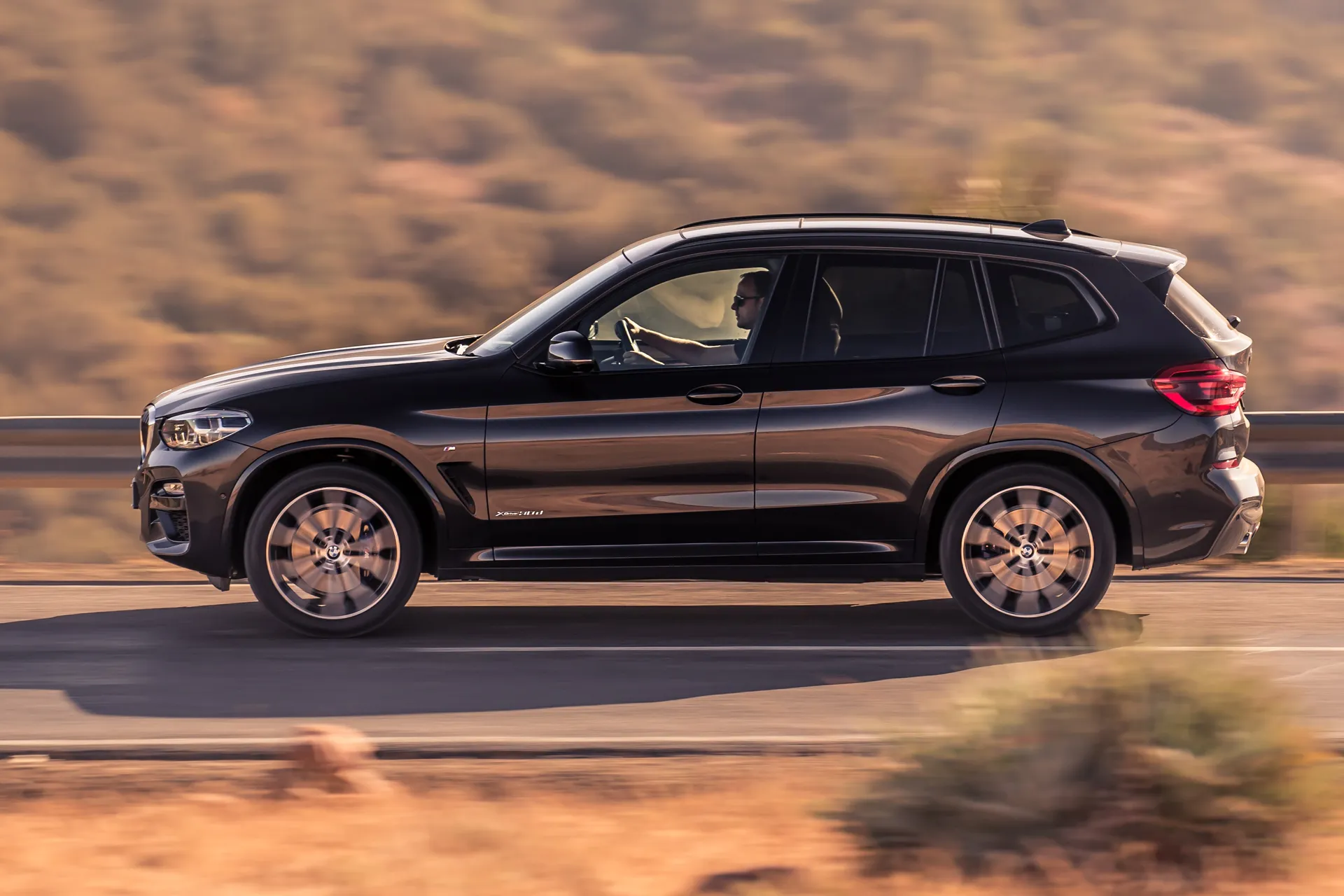
BMW has introduced mild-hybrid technology on its diesel models, with an upgraded electrical system that can harvest energy when braking, and shut off the engine for short periods while cruising to help save fuel.
The results speak for themselves in the X3. Under WLTP tests, the 20d can return close to 50mpg, and even more impressively, the six-cylinder 286PS 30d is barely any less efficient, with an official 45mpg.
Expect those figures to fall in normal driving, or if you fit larger wheel sizes. Petrol models aren't as frugal, with an official 36mpg for the 20i, but our Real MPG results suggest that is almost achievable in the real world.
If you have a short commute, the 30e PHEV could be just the ticket. Its electric motor means the car can travel up to 30 miles without burning any fossil fuel, so it claims more than 120mpg in official tests. To get close to that, you'll need to regularly charge the batteries, and this takes over five hours with a three-pin plug. Using a 7kW wallbox cuts that time in half.
Obviously, the M Performance models aren't as efficient. Nevertheless, the M40d will be capable of over 40mpg in the real world, while around 30mpg would be expected for the M40i. The full-fat X3 M, however, will return around 25mpg. Not bad for the performance, but you have to ask yourself whether all that performance is really necessary in an SUV.
How reliable is the BMW X3?
BMW finished in the top half of brands in the latest HonestJohn.co.uk Satisfaction Index, placing 12th out of the 29 carmakers considered. This study assesses reliability alongside other aspects of customer satisfaction. This performance put BMW ahead of rival premium brands such as Mercedes-Benz, Audi and Volvo, but behind others such as Jaguar, Land Rover, Porsche and Lexus.
We haven't heard any horror stories specific to this generation of the X3, which should bode well. The car comes with a three-year, unlimited-mileage warranty, which is marginally more generous than the bare minimum that many other manufacturers provide.
Insurance groups and costs
Getting coverage for the BMW X3 should inflict less financial pain on you than some of its close rivals will. The lowest rated (and therefore cheapest) model to insure is the xDrive 20i petrol. In SE trim it's in Group 28.
That's seven insurance bands lower than an Audi Q5 or Mercedes GLC, although both rivals do come with a more powerful engine as standard. Diesel drivers needn't fear, though, as a 20d is only band higher in Group 29.
Of the quicker models, the plug-in hybrid xDrive 30e is the most affordable, sitting up in Group 38. That might be a big jump up from the normal four-cylinder cars, but it's still less than PHEVs from other premium brands.
If you want six-cylinders, though, expect your insurer to ask for a hefty annual premium. Both the 30d and M40i are in Group 40, while an M40d (which is less powerful than its petrol sibling) goes all the way up to Group 45.
VED car tax: What is the annual road tax on a BMW X3?
The current BMW X3 was launched in 2018, which means all petrol and diesel models pay the same flat-rate of tax regardless of their efficiency, which is currently £190 per year. The plug-in hybrids get a £10 discount off that.
There's a sting in the tail, though, as most X3s cost more than £40,000 when brand new (all later ones did), so they are liable for a temporary luxury tax rate during the first six years of ownership, pushing the annual cost up to £580 for the non-hybrid models, and £570 for plug-in ones.
The 30e will also be the first choice for company car users, since its 14-16% Benefit-in-Kind rate is less than half the 37% of all the other models in the range, potentially saving you several thousand pounds each year.
How much should you be paying for a used BMW X3?
"It’s been on sale for a few years now, so there are plenty of low mileage used BMW X3s on the market. The current car is the best yet in terms of its build quality, so picking one up nearly new is a great way to save on optional kit."
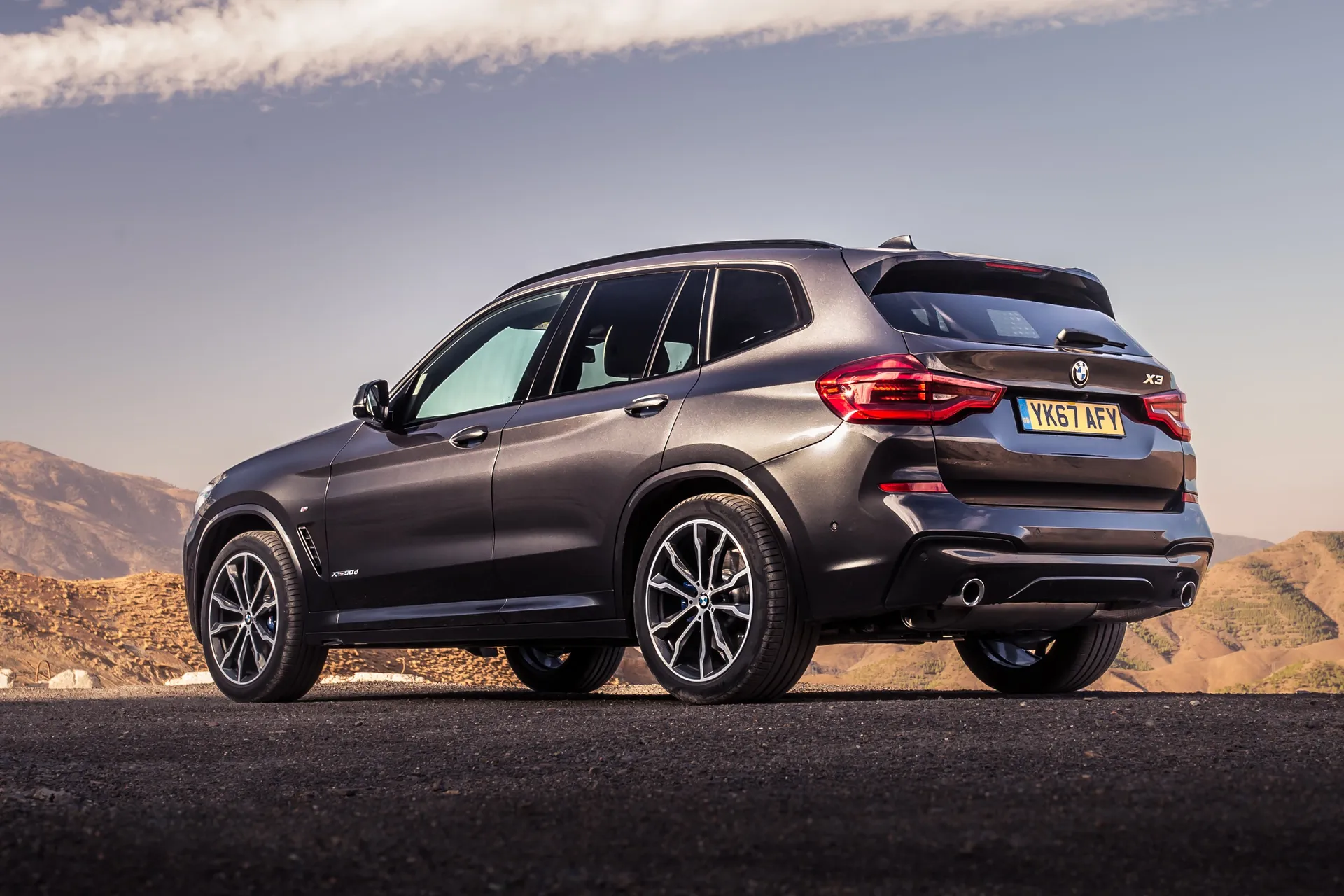
The popularity of the BMW X3 means there's plenty of choice out there, whether you're looking to bag a deal on a nearly new or pre-registered model, or save more money with a used example.
The most affordable third-generation X3s in our listings come in at around the £22,000 mark. These are mainly 20i and 20d variants from 2018 and 2019 with between 50,000-70,0000 miles on the clock, and a variety of different trim levels are available at that price.
If you're looking for something a bit newer, year-old examples with the more modest powertrains will cost you upwards of £40,000, while the M40i and M40d versions will be upwards of £50,000.
Trim levels and standard equipment
Every version of the BMW X3 comes so generously equipped that the only real reason to travel up the various trim levels (SE, xLine, M Sport, and M40i) is to alter the way it looks, although there are a few subtle differences.
The 'basic' model is nobody's idea of a poor cousin, with heated leather seats, an electric tailgate, triple-zone climate control, bright LED headlights, 18-inch alloys, cruise control, and BMW's brilliant iDrive infotainment.
SE trim was later dropped to make the previously second-rung xLine model the entry-point. These versions appear tougher on the outside, with some off-road inspired underbody protection and 19-inch alloys, but apart from a set of snazzy sports seats, there is little to distinguish it from SE trim on the inside.
Early M Sport cars did get a meaningful spec bump, though, with an upgraded infotainment system that has a 10.25-inch screen, the latest software, and a 12.3-inch set of digital dials that looks super slick and modern. After the 2021 facelift, all trims got the same pair of 12.3-inch screens as standard.
The M40i and M40d get their own unique specification, with sporty details, electric front seats with a memory function, uprated brakes and 20-inch alloy wheels among the highlights, along with bespoke suspension. The X3 M takes that sporty theme a step further, with an aggressive bodykit, lots of performance add-ons and the option of figure-hugging carbon-backed bucket seats.
As you would expect on a premium model, there are lots of opportunities to upgrade the BMW X3 by ticking a few option boxes, but be warned, this will quickly push up the price. Many of these are organised into packs, many of which look expensive.
Ask the heycar experts: common questions
What is the difference between the BMW X3 and the X5?
What is the BMW X3 like second hand?
How much boot space does the X3 have?
Get our latest advice, news and offers
Keep me updated by email with the latest advice, news and offers from heycar.
By submitting you agree to our privacy policy





